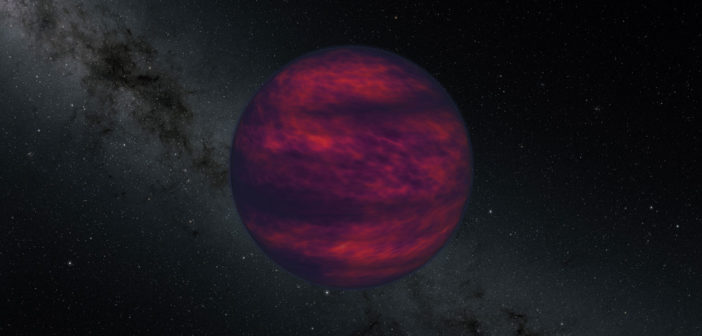Editor’s Note: Astrobites is a graduate-student-run organization that digests astrophysical literature for undergraduate students. As part of the partnership between the AAS and astrobites, we occasionally repost astrobites content here at AAS Nova. We hope you enjoy this post from astrobites; the original can be viewed at astrobites.org.
Title: The Perkins INfrared Exosatellite Survey (PINES) II. Transit Candidates and Implications for Planet Occurrence around L and T Dwarfs
Authors: Patrick Tamburo et al.
First Author’s Institution: Boston University
Status: Published in AJ
Today’s authors search for planets — not around stars, but around brown dwarfs!
Not a Star and Not a Planet
Brown dwarfs are mysterious cosmic objects.
Are they stars? They can fuse deuterium, and the largest ones can even fuse lithium! But they are not massive enough to fuse hydrogen into helium, so they are not classified as stars.
If they are not stars, are they planets? Again, no. They are self-luminous, unlike their less massive gas giant counterparts.
Confusingly, brown dwarfs are not stars and not planets, but their own class of celestial object.
Not Stars, but Still Planet Hosts?
Historically, astronomers and the general public alike have viewed stars as the hosts of planets. In fact, one of the facets of the International Astronomical Union (IAU) definition of a planet is that a planet is “in orbit around the Sun” (check out these two astrobites to learn more about the IAU). We now know of many planets that orbit stars other than the Sun, but today’s authors go one step further: they have begun searching for planets that orbit brown dwarfs.
Research has shown that the occurrence rate of short-period, super-Earth-sized planets increases with decreasing stellar mass; M dwarfs host about three times as many of these planets as F dwarfs. This anti-correlation could continue beyond the main sequence and into the brown dwarf mass range. However, models have shown that the protoplanetary disks around brown dwarfs may not have enough material to form planets. Prior to today’s article, only one planet around a brown dwarf was known. Today’s authors search for additional planets orbiting brown dwarfs to learn more about these fascinating systems.
In the PINES
Today’s authors obtained 131 brown dwarf light curves using the Mimir instrument on Boston University’s 1.8-meter Perkins Telescope. They then developed an algorithm to search for transiting planets in their light curves. They have designated their search “PINES” (Perkins INfrared Exosatellite Survey).
This search yielded two brown dwarfs with candidate transits. The first — 2MASS J18212815+1414010 — is known to be a variable brown dwarf, so it is unlikely that the signal they detected was from a transiting planet.
The second transit candidate, however, is more intriguing. The authors detected a potential super-Earth around 2MASS J08350622+1953050 (see Figure 1). The potential planet’s radius could be as large as 5.8 Earth radii if the host is young or as small as 4.2 Earth radii if the host is old. Brown dwarfs contract considerably as they age and cool, so the estimate of the planet candidate’s radius is highly dependent on the brown dwarf’s age. The surface gravity of 2MASS J08350622+1953050 indicates that the brown dwarf is more than 100 million years old, but it could be as old as ten billion years! The authors state that it is more likely 2MASS J08350622+1953050 is fully contracted, but they cannot rule out larger planetary radii without placing firmer constraints on the brown dwarf’s age.

Figure 1: Top: The uncorrected light curve for 2MASS J08350622+1953050. The model fit is shown as a blue line. It is flat, indicating no apparent variability. Bottom: The corrected light curve, which is very similar to the uncorrected light curve due to the flat model. The signal-to-noise ratio of the suspected transit event is indicated with an arrow. [Adapted from Tamburo et al. 2022]
The authors also performed injection and recovery tests to estimate the likelihood of detecting a planet with a radius similar to the one estimated for 2MASS J08350622+1953050’s planet candidate. Assuming that brown dwarfs host the same number of short-period planets as M dwarfs, the authors calculate a 1% chance of detecting a planet if the host is old, and a 0.13% chance of detecting a planet if the host is young. These results indicate that we are unlikely to detect a planet of this radius with these 131 brown dwarf light curves, unless brown dwarfs host more short-period planets than M dwarfs. This conclusion supports the anti-correlation between planet occurrence rates and stellar mass, which challenges current planet formation models and opens up the possibility of detecting additional worlds orbiting our brown dwarf neighbors.
More Brown Dwarf Planets to Come
The authors are continuing their search for planets around brown dwarfs. As they are searching for single transit events, the periods of these planets are unknown, and their transits cannot be predicted. This makes them unfavorable targets for oversubscribed space missions such as Hubble or JWST. However, ground-based surveys like PINES are perfect for finding these single-transit planets around not-quite-planets.
Original astrobite edited by Isabella Trierweiler.
About the author, Catherine Clark:
Catherine Clark is a PhD candidate at Northern Arizona University and Lowell Observatory. Her research focuses on the smallest, coldest, faintest stars, and she uses high-resolution imaging techniques to look for them in multi-star systems. She is also working on a Graduate Certificate in Science Communication. Previously she attended the University of Michigan, where she studied Astronomy & Astrophysics, as well as Spanish. Outside of research, she enjoys spending time outdoors hiking and photographing, and spending time indoors playing games and playing with her cats.

